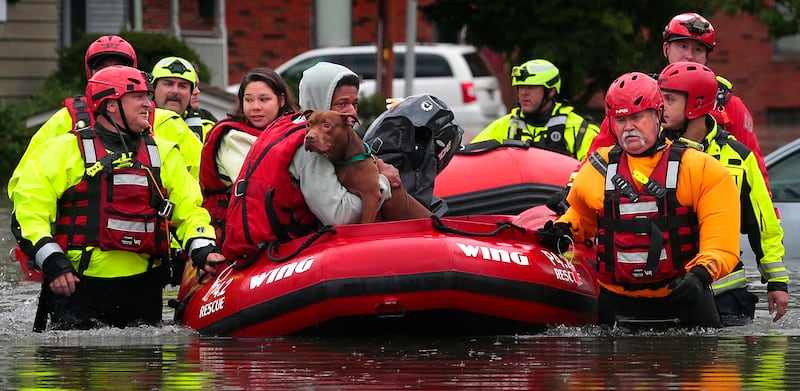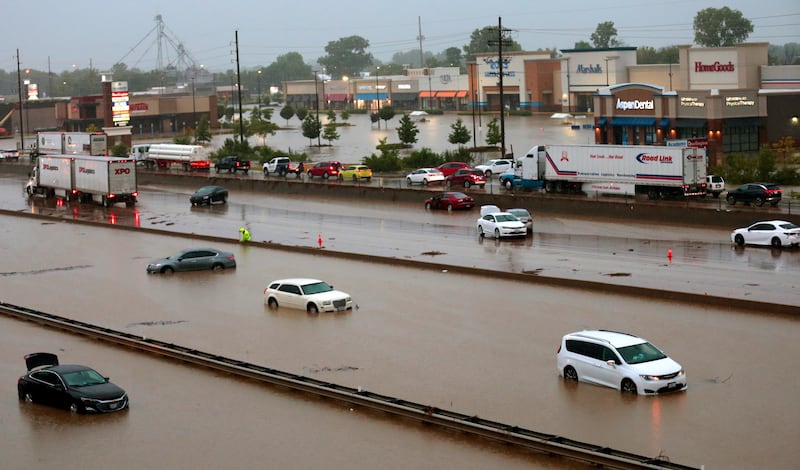Up to 12 inches of rain pummeled the St. Louis, Missouri, area after a storm stalled over the urban area Tuesday. The flash flooding led to the death of one person found in a car submerged in more than eight feet of water.
While the area had been in drought, the concrete surfaces of the metropolitan area were not able to absorb the water from the freak storm and became inundated with water.
What happened: The massive downpour happened early Tuesday dumping up to a foot of rain in just a brief time, prompting the rescue of hundreds of people stranded by the flash flooding.
ABC News reported that several puppies drowned when flood waters overwhelmed a stray dog rescue operation in a suburb of St. Louis, and firefighters used boats to save other dogs at the shelter.
The news channel reported that the rain was so intense, several interstates were closed and residential roofs were under threat of collapse. The freak storm even caused the iconic Gateway Arch to close for the day.
Leaders declared a state of emergency and looked to the White House for help, according to KSDK news.

Elsewhere in the country: San Antonio is in the grips of a perilous heat wave, impacting the homeless and low-income people in particular. The New York Times reported that the National Weather Service there logged 46 days of temperatures exceeding 100 degrees, making even simple trips to the store a dangerous adventure because of the stifling heat.
The heat wave has been blamed for wildfires and has also challenged the Lone Star State’s power grid, with officials pleading for less use of air conditioners and other electrical appliances to ease the strain on power supplies.
Texas power officials have warned there could be rolling “blackouts” lasting up to 45 minutes because of the excessive demand on the grid amid the sweltering heat.
The Texas Tribune reported the situation had not become that dire — as of yet — but power officials are closely eying conditions to keep the grid operable.
Fires in California: St. Louis, Missouri, was deluged with flash flooding — and a warning exists for southern Utah Wednesday — prompting the Salt Lake City office of the National Weather Service to provide cautionary advice. But much of the West is burning, particularly Yosemite in California.
California’s largest wildfire this year, the Oak Fire, has scorched closed to 17,000 acres and ripped through multiple structures. Several thousand households and businesses are at risk in the region of Sierra Nevada.
The haze from the fire obscured the normally dramatic views at Yosemite National Park and threatened air quality, according to the Guardian.
Even Utah air quality regulators are reporting elevated levels of PM2.5, or fine particulate matter, as the wildfire season grips the West.
More information on local air quality conditions can be found on the Utah Division of Air Quality’s website.
A new study detailed Wednesday by the University of Utah indicates the plumes of smoke crawling upward from Western wildfires have trended taller, with more smoke and aerosols lofted up where they can spread farther and impact air quality over a wider area, a release said. The likely cause is climate change, with decreased precipitation and increased aridity in the Western U.S. that intensifies wildfire activity.
“Should these trends persist into the future,” says Kai Wilmot, a postdoctoral researcher in the Department of Atmospheric Sciences at the University of Utah, “it would suggest that enhanced Western U.S. wildfire activity will likely correspond to increasingly frequent degradation of air quality at local to continental scales.”
The study published in Scientific Reports is based on an analysis and modeling of 4.6 million plumes of smoke from wildfires in the West.



